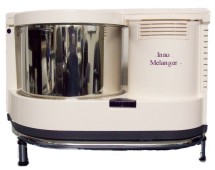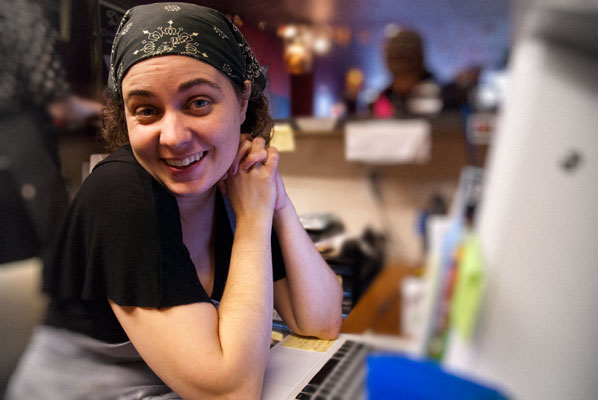I visited my pal Rachel Sawatzky, the Cocoa Nymph, this week. She has a fabulous chocolate shop on the west side of Vancouver. I got to work there for a day, last year, and my respect for the artisans who dip and decorate beautiful chocolate truffles and bonbons increased tenfold by the end of the day, when my back and legs were cramped and my fingers permanently (or so it felt) curled, as though around a metal dipping fork.
And I loved it. It was great to spend a day in a vibrant, active, delicious smelling business, immersed in chocolate and friendly people. Cocoa Nymph has devoted regular customers who come in for a truffle, a special occasion gift, to take a dipping workshop or for a cup of delicious drinking chocolate topped with a house made marshmallow.
Rachel, a successful chocolatier who got into the business while studying biochemistry, is like a breath of fresh air to be around: an energetic, fiercely intelligent person who is always keen to take on new challenges.
Today, she has generously offered to show me her latest endeavor. She calls it her Bean to Bar Beginnings.
Rachel reminds me that there are about ten steps in the production of chocolate from the bean (after it has been harvested and fermented in the field, then dried and stored for shipment) to its most commonly recognized form – the solid bar.
These involve testing, cleaning, roasting, cracking (or fanning), grinding, refining, conching, tempering and forming bulk chocolate. The steps are thoroughly described in an article on the Ecole Chocolat website.
The chocolatier then goes through a few more steps to create fine bonbons, truffles and molded chocolates.
So today, Rachel is “backing up” a few steps in the process of fine chocolate making, working with 5 kilos of roasted Ecuadorean cacao nibs.
 In her workshop she has a hard working UltraGrind+ melangeur, affectionately known as the Beanie Genie.
In her workshop she has a hard working UltraGrind+ melangeur, affectionately known as the Beanie Genie.
The forerunner of this amazing little machine was devised for grinding lentils for making idlis and dosas, but its conical granite stone rollers rotating on a granite slab are perfect for grinding cocoa beans and nibs to the correct micron size for smooth tasting chocolate.
In fact, its inventor, Andal Balu, received an Innovation in Fine Chocolate Products Award at the Fine Chocolate Recognition of Excellence Awards, last January:
The Beanie Genie is grinding away when I arrive. Rachel adds the nibs in small amounts to allow the machine time to absorb and grind them uniformly into a thick liquid. She plays a heat gun over the machine’s opening, to assist the cacao nibs in liquefying. As the machine works, the temperature rises and the mixture creates its own heat as it spins, giving off a rich chocolate aroma.
I can feel the generated heat on the outside of the machine. It can go for hours without overheating. The rotating housing contains a round granite slab, and as I peer in, I can see the conical grinders rotating over it, pressing the nibs between, releasing the cocoa liquor, then throwing them up again and into the mixture. With each addition of nibs, the machine slows to accommodate the crushing of the new nibs, then builds up sped and heat, releasing more chocolate aroma. It is mesmerizing.
While the machine works away we talk about her first experience tasting single origin chocolate:
“I was still going through the Ecole Chocolat program, and I bought a Pralus tasting box, which cost a small fortune to me – I had no money. I remember tasting a small square of chocolate that tasted like it had been smoked. This was due to the eruption of Mount Pinatubo in 1991, and effect on the soil these cocoa beans had grown in.”
Fine chocolate, just like fine wine, has terroir – the special characteristics of a food which come from the climate, growing conditions, geography, soil composition, plants growing around it, sunlight, and rainfall all interacting with the genetics of the plant to produce particular flavours.
And, just like fine wine, there is a growing market for chocolate made from beans from a single region, or even a single plantation. This chocolate is almost the antithesis of the chocolate we have been used to, as large companies must produce chocolate with a consistent flavour profile, whereas this method of producing small batches of chocolate celebrates the differences in each harvest of beans.
Just as a fine wine will have a certain vintage, with widely varying characteristics from year to year, so too will the chocolate produced from the beans of a particular plantation, and a particular harvest.
If the demand for high quality cacao beans increases, hopefully this will be good news for the small family cacao farmers, who in some cases only have a couple of hectares of land to farm and who, up until recently were paid for the volume of beans produced, high and lower quality beans being put together to produce chocolate of a homogenized flavour. Hopefully, in the near future, they will be able to demand a better price for growing fine quality beans.
Rachel is using 5 kilos of nibs from two very different regions – one from Ecuador, the other from Madagascar. They are each being ground for eight hours and from there she will add organic cane sugar to each batch, then grind and conche (the vitally important step in making chocolate, which smoothes the particles and releases unwanted acidic gases) in the Beanie Genie.
From 5 kilos of nibs, she estimates she will produce 7 1/2 kilos of 70% chocolate. The added sugar will determine the cocoa content, as it is the only other ingredient being added, so to make 70% cocoa chocolate, 30% sugar is added (2 ½ kilos sugar). This measurement changes, of course, if other ingredients are added, such as flavourings or milk crumb (to make milk chocolate).
She gives me a taste of the resting batch of recently ground Madagascar beans. Even at this early stage it is easy to detect a bright, citrusy, tropical fruit taste – Rachel laughingly says “kind of like a pina colada”.
This is in marked contrast to the Ecuadorean beans in the Beanie Genie which have a much “darker” taste – nutty, almost coffee.
But this is truly, only the beginning. From these two sets of beans, she will be able to produce test batches of varying percentages of cacao, and using shorter or longer lengths of conching (the longer you conch, the smoother the texture and taste of the product, but you may also lose some of the beans flavour characteristics the longer you go), she will be able to adjust the texture and mouth feel of the finished chocolate.
Even with “backing up a few steps” in the process, I am once again, struck by how much opportunity there is at any stage in the chocolate making process to alter what ends up in the bar, and this only increases my respect for the scientist’s knowledge and artist’s flair necessary for making a really fine chocolate.
I am so interested to see what Rachel comes up with. I know she is planning to do some selective taste testing of her finished products in the months to come, and I hope I am invited to try them, as I was fortunate enough to see their beginnings.
You can find out more about Rachel Sawatzky in this video:
You can find out more about Bean to Bar manufacturing in this Chocolate Masters Hangout video courtesy Ecole Chocolat:
